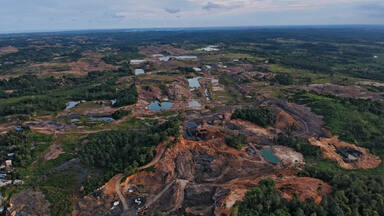The World Heritage Committee,
- Having examined Documents WHC/16/40.COM/7, WHC/16/40.COM/7A, WHC/16/40.COM/7A.Add, WHC/16/40.COM/7A.Add.2, WHC/16/40.COM/7B, WHC/16/40.COM/7B.Add and WHC/16/40.COM/7B.Add.2,
- Recalling Decision 39 COM 7, adopted at its 39th session (Bonn, 2015),
Emergency situation resulting from conflicts - Deplores the conflict situation prevailing in several countries, the loss of human life as well as the degradation of humanitarian conditions and expresses its utmost concern at the damage sustained and the threats facing cultural and natural heritage in general;
- Urges the States Parties to ratify international instruments such as the Convention for the Protection of Cultural Property in the Event of Armed Conflict and implores States Parties associated with conflicts to refrain from any action that would cause further damage to cultural and natural heritage and to fulfil their obligations under international law by taking all possible measures to protect such heritage, in particular the safeguarding of World Heritage properties and the sites included in the Tentative List;
- Also urges the States Parties to adopt measures that oppose World Heritage properties being used for military purposes;
- Takes note of the progress made by the World Heritage Centre and the Advisory Bodies to launch a reflection on a post-conflict recovery strategy, and of the support extended so far through technical assistance, capacity-building, and exchange of best practices in this regard, and recommends that further support for threatened or damaged World Heritage properties be pursued;
- Notes with concern that the conflict situation in several countries in the world has increased considerably the work load of the World Heritage Centre staff, and that an adequate implementation of the Action Plans for the Emergency Safeguarding of Cultural Heritage in Mali, Syria, Iraq, Libya and Yemen requires additional financial and human resources at the World Heritage Centre and in the UNESCO field offices; also notes the increased demands on the resources of the Advisory Bodies;
- Calls on the international community to provide financial support for the implementation of the UNESCO Action Plans for the Emergency Safeguarding of Cultural Heritage in Syria, Iraq, Libya and Yemen, including for additional human resources at the World Heritage Centre and in the UNESCO field offices;
- Also expresses its utmost concern about the impacts of conflicts causing an escalation of the already severe poaching crisis, as armed groups are financing their activities through illegal wildlife trade, which is having a severe impact on African wildlife, threatening the very survival of species and the Outstanding Universal Value (OUV) of World Heritage properties;
- Launches an appeal to all Member States of UNESCO to cooperate in the fight against the illicit trafficking of cultural heritage objects and illegal wildlife trade, including through the implementation of the Convention on International Trade in Endangered Species of Wild Fauna and Flora (CITES), the ratification of the 1970 Convention on the Means of Prohibiting and Preventing the Illicit Import, Export and Transfer of Ownership of Cultural Property and to pursue the implementation of the United Nations Security Council Resolution 2199 of February 2015 regarding Syria and Iraq;
Other conservation issues
Reconstruction
- Noting that the recent and wide-ranging deliberate destruction of World Heritage properties as a result of armed conflict in Syria, Yemen, Libya, Iraq, Mali and Nigeria, and the devastating earthquakes in Nepal, have brought sharply into focus the issue of reconstruction in World Heritage properties; that several international meetings have taken place or are being planned on reconstruction; and that guidance within the Operational Guidelines is currently inadequate,
- Recommends that more in depth reflection is needed on reconstruction within World Heritage properties as a complex multi-disciplinary process, and that consideration should be given to developing new guidance to reflect the multi-faceted challenges that reconstruction brings, its social and economic context, the short- and long-term needs of properties, and the idea of reconstruction as a process that should be undertaken within the framework of the Outstanding Universal Value (OUV) of the properties;
- Welcomes the offer of the Government of Poland to host an international conference on Reconstruction to provide guidelines to the World Heritage Committee;
Climate Change - Taking note of the agreement reached during the 21st conference (COP21) of the United Nations Framework Convention on Climate Change (UNFCCC) held in 2015, requests the World Heritage Centre and the Advisory Bodies to assist States Parties to implement appropriate management responses to the adverse effects of Climate Change;
- Recommends that the World Heritage Centre strengthen its relations with other organizations working on Climate Change, particularly with the UNFCCC and the Intergovernmental Panel on Climate Change (IPCC) secretariats, and specifically with regard to the effect of Climate Change on World Heritage properties, and also requests the States Parties, the World Heritage Centre and the Advisory Bodies to work with IPCC with the objective of including a specific chapter on natural and cultural World Heritage in future IPCC assessment reports;
- Further requests the World Heritage Centre and the Advisory Bodies to periodically review and update the “Policy Document on the Impacts of Climate Change on World Heritage properties”, so as to make available the most current knowledge and technology on the subject to guide the decisions and actions of the World Heritage community;
Dams - Notes with significant concern that an increasing number of properties are facing potential threats from major dam projects, considers that the construction of dams with large reservoirs within the boundaries of World Heritage properties is incompatible with their World Heritage status, and urges States Parties to ensure that the impacts from dams that could affect properties located upstream or downstream within the same river basin are rigorously assessed in order to avoid impacts on the Outstanding Universal Value (OUV);
Extractive industries - Noting with significant concern that World Heritage properties are increasingly threatened by extractive industries, as confirmed by the 2014 IUCN World Heritage Outlook report, by the World Heritage Centre’s analysis of issues reported in state of conservation reports also revealing the potential threat from extractive activities to cultural properties, and by the 2016 report by the World Wide Fund for Nature (WWF), welcomes the “No-go” commitments to World Heritage properties made by Tullow Oil plc and CEMEX in November 2015 and April 2016 respectively, and reiterates its call on other extractive industry companies and investment banks to follow these examples to further extend the “No-go” commitment;
- Recalling Decision 37 COM 7, once again urges all States Parties to the Convention and leading industry stakeholders to respect the “No-go” commitment by not permitting extractive activities within World Heritage properties, and by making every effort to ensure that extractives companies located in their territory cause no damage to World Heritage properties, in line with Article 6 of the Convention;
Environmental Impact Assessments (EIAs)/Heritage Impact Assessments (HIAs) - Notes with concern that a majority of properties potentially affected by proposed development projects, proposed legal instruments, and proposed management systems have not benefited from an assessment of impacts on their Outstanding Universal Value (OUV) in line with IUCN’s World Heritage Advice Note on Environmental Assessment and ICOMOS’ Guidance on Heritage Impact Assessments for Cultural World Heritage Properties, and requests all States Parties to the Convention to ensure that potential direct, indirect and cumulative impacts on the OUV, including from projects located outside the boundaries of natural and/or cultural World Heritage properties, are specifically assessed within the framework of the EIA and HIA required by the applicable laws and regulations, and that reports of such assessments are submitted to the World Heritage Centre for review by the Advisory Bodies, in accordance with Paragraph 172 of the Operational Guidelines;
- Recalls Article 6 of the Convention according to which “Each State Party to this Convention undertakes not to take any deliberate measures which might damage directly or indirectly the cultural and natural heritage […] situated on the territory of other States Parties to this Convention”, and also requests all States Parties to the Convention to ensure that EIAs and HIAs include an assessment of impacts on the OUV of World Heritage properties situated on the territory of other States Parties, as appropriate;
- Further requests the Advisory Bodies, in consultation with the World Heritage Centre, to consider opportunities to streamline their guidance on impact assessment in order to develop one single guidance document for the assessment of impacts on both natural and cultural properties;
Integrated management, Decision making, Governance - Noting with concern that the lack of an integrated management approach is reported to cause challenges to the coordination of management and decision making processes of properties where different authorities are involved, in particular in the cases of mixed, serial, and transboundary properties, urges States Parties to establish appropriate mechanisms in order to facilitate a coordinated approach to the management of all properties, in line with the requirements of the Operational Guidelines as laid out in Paragraphs 112, 114, and 135, and encourages States Parties with contiguous natural properties on either side of their international borders, which are not listed as transboundary properties, to establish appropriate mechanisms for cooperation between their respective management authorities and ministries;
- Also encourages States Parties to promote recognition and awareness across all relevant national and regional agencies of the World Heritage status of the properties on their territory, and to develop mechanisms to ensure consideration of impacts on Outstanding Universal Value (OUV) in the decision making processes of relevant ministries, before permits are issued for developments that could negatively impact the OUV;
Ground transport infrastructures - Notes with concern that the number of cases of ground transport infrastructure having potential impact on the Outstanding Universal Value (OUV) of World Heritage properties is continuing to grow, and calls upon States Parties to carry out Strategic Environmental Assessments (SEAs) early in the process of transportation planning to allow for potential impacts of the OUV, including those resulting from foreseeable associated future developments, to be identified prior to the development of specific projects;
- Encourages States Parties to carry out Environmental Impact Assessments (EIAs) and Heritage Impact Assessments (HIA) on ground transport projects, once they are designed, with multiple options to ensure that transportation needs can be met with minimal impacts on the OUV of World Heritage properties;
List of World Heritage in Danger - Takes note of its discussions under agenda items 7A and 7B, and requests the World Heritage Centre, in consultation with the Advisory Bodies and States Parties, to promote better understanding of the implications and benefits of properties being inscribed on the List of World Heritage in Danger, and to develop appropriate information material in this regard with a view to overcome the negative perceptions of the List of World Heritage in Danger. The information material should highlight the importance of the protection of the OUV;
Reactive Monitoring - Requests the World Heritage Centre, in cooperation with the Advisory Bodies to evaluate the effectiveness of the Reactive Monitoring including procedures and case studies and to present a preliminary report for the consideration by the World Heritage Committee at its 42nd session in 2018, if funds are available.

